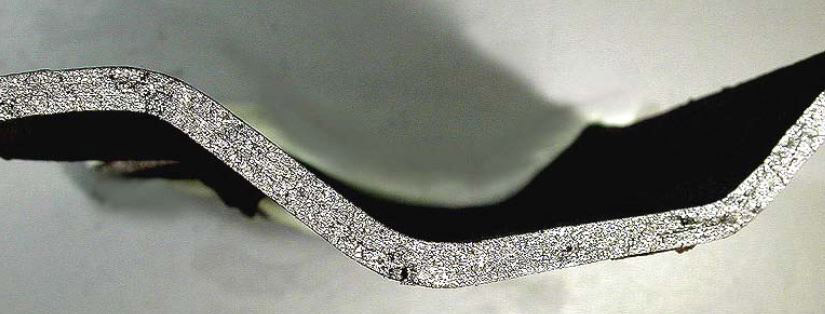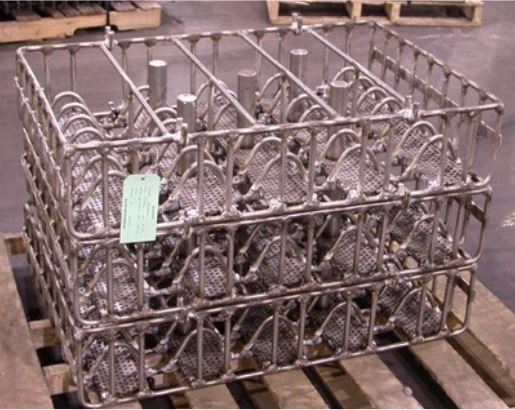CARBURIZATION
Pack hardening is uncommon today, except in a few custom made sporting arms. Now, low carbon steel parts are heated in a prepared furnace atmosphere that provides the carbon that diffuses into the surface layers of the steel. Temperatures are usually around 1750°F (950°C). This atmosphere has traditionally been “endothermic”, using a catalyst to partially burn natural gas. Typical composition 1 of an endothermic gas (Class 302) is 39.8% nitrogen, 20.7% carbon monoxide, 38.7% hydrogen and 0.8% methane, with a dew point – 5°F (– 20°C). This carrier gas is subsequently enriched by a small, controlled addition of a hydrocarbon gas, such as propane, or an easily vaporized liquid, which is the source of carbon. 100% nitrogen, from bulk tanks, may also be used as a carrier gas, with propylene or other hydrocarbon injected to provide the necessary carbon.
In vacuum, or low pressure, carburizing acetylene , C2H2 or cyclohexane, C6H12 , is used as the source of carbon. The end result is that low carbon steel parts acquire a high carbon steel surface. When the steel is quenched it combines the hardness and wear resistance of this high carbon steel “case” with the toughness of the low carbon steel interior (core).
The alloy bar frame baskets2 , radiant tubes and other fixturing in the furnace also pick up carbon through many, many heat treat cycles. These fixtures are made of carburization resistant alloys. Even though the atmosphere is reducing to iron, it is still oxidizing to chromium, silicon, and aluminum. An oxide scale, some mixture of Cr2O3 , SiO2 and Al2O3, forms on or just beneath the surface. This oxide layer is what provides most of the alloy’s resistance to carburization.
Carburization embrittles high temperature alloys, so that they can neither be straightened nor weld repaired. The degree of embrittlement depends upon the amount of carbon absorbed3, and upon the microstructure. Generally speaking, once an alloy has absorbed about 1% carbon it will no longer have measurable room temperature ductility. We once examined a sample of 310 sheet which contained 4% carbon, and could readily be broken by hand. With carburized alloy, enough ductility may remain while at red heat for the metal to perform its task. This, so long as it is not excessively strained at high temperature, or impacted at room temperature.

Alloy 601 used in a powdered iron sintering muffle. Grain growth is from the operating temperature. Brittle fracture at room temperature comes from the large amount of carbon, 2.34%, absorbed during service. The nitrogen – hydrogen atmosphere is not supposed to be carburizing. Nevertheless, carbon enters the atmosphere from the organic compounds used as binders in the “green” powder compact.
Carburization resistance in an alloy is conferred almost entirely by the protective oxide scale4, along with the nickel content. The oxide scale is primarily chromia, with silicon being a very potent assist5. Nickel lowers the solubility of carbon in the alloy, so that a very high nickel grade simply will not carburize to the same level as will a lower nickel material.
In vacuum carburizing there is too little oxygen present to form chromium or silicon oxides for protection. Such carburization resistance as an alloy has may come largely from its aluminum content, which will form alumina in this process.
Among the alloys, RA330 usually does the best job for the money. RA333, RA600, RA 353 MA, RA601 and RA 602 CA are all more carburization resistant but also more expensive. 800H does not well tolerate the effects of carburization, in part because it lacks silicon but also, and more importantly, because it is invariably coarse grained.
RA 253 MA has worked as furnace fixturing because it is strong, but RA 253 MA is not resistant to carburization. Even RA309 has somewhat better carburization resistance than does RA 253 MA. The common stainless alloys 304 and 316L do not possess adequate resistance to carburization for use as fixturing in commercial carburizing heat treat furnaces. The ferritic grade 446 is quite poor in carburization resistance.
When nickel heat resisting alloys become carburized, it happens that many also become magnetic. A pocket magnet, then, becomes a handy tool to judge whether or not alloy fixturing has enough ductility remaining to be weld repaired or straightened.
Not due to carburization, but a purely mechanical problem that may occur in a carburizing atmosphere is of some concern. Soot may deposit from the atmosphere and “coke” in any crevices, such as cracks in weld joints or surface defects on castings. The growth of this soot deposit acts like tree roots growing in rock . It literally pries open lack of fusion in the weld or opens small pin – holes in castings into large cavities.
In the case of wrought alloys, which are free of surface defects, we emphasize the need to have designs and weldments that do not provide crevices in which carbon deposition may occur. This is one reason why full penetration welds of the return bend to straight leg are essential for maximum life in radiant tubes. On low fire soot may deposited in the root crevice (as well as in surface defects of cast return bends). On high fire this soot burns out, locally overheating and weakening the metal.
Carburization Testing
Laboratory carburization testing must be carried out in some approximation of the industrial atmosphere of interest. The test temperature should be similar to that anticipated in service. In addition it would be a good idea to include thermal cycles about like the expected service conditions6. Finally, duration of the test is important.
Carburization resistance depends upon the chromia scale, the silica subscale, and the alumina scale in some alloys. For this reason the test atmosphere should, in our opinion, contain an oxygen partial pressure comparable to the expected service atmosphere, in order to form a similar protective scale7. One may also wish to consider nitrogen, as nitrogen the atmosphere reacts with alloying elements such as chromium, and may affect carburization.
There have been laboratory carburization tests run in an atmosphere of hydrogen — 2% methane, with no control of oxygen partial pressure. In this environment the alloy will not develop much of a protective scale. Such an atmosphere is one way to achieve the objective of actually carburizing most alloys.
Very small amounts of oxygen can form enough alumina or titania scale, for example, to inhibit braze flow in many vacuum furnaces. Alloy 800H contains enough titanium to turn light gray in some vacuum heat treat furnaces.
In order to braze even stainless steel (with no Al or Ti) in hydrogen it is normally considered that the dew point should be – 60°F (– 51°C) or lower8. This is necessary to dissociate the oxides of most alloying elements. Alumina and titania will not be dissociated by this atmosphere. One might expect that grades such as N06601, N06025 and N0811 would form aluminum and titanium oxide films in a nominal hydrogen — methane atmosphere. Such films may affect carburization.
Recent work by George Lai, in H2-CH4, ranks several alloys in the same order as does service experience. Oxygen partial pressure was not indicated. Dr. Lai’s ranking of wrought alloys, from best to worst is: Haynes ® 214, RA 602 CA © , Incoloy ® 803, 800H, and 310 stainless. The ranking is the same, whether based on weight change or on measured depth of carburization. Alloy ranking is approximately in accordance with their aluminum + titanium contents. Al and Ti are is the elements most likely to form a scale in this test. We might infer that these methane – hydrogen test results could have some relevance to performance of alloy fixturing in a vacuum carburizing furnace. In vacuum carburizing very small amounts of oxygen are present from the furnace leak rate, if nothing else.
Carbon Content, weight %, Before and After Testing
Carbon Content, weight %, Before and After Testing
| Alloy | Original | Final | Increase | %Al |
|---|---|---|---|---|
| 214 | 0.042 | 0.50 | 0.008 | 4.5 |
| RA 602 CA | 0.19 | 0.36 | 0.17 | 2.2 |
| 803 | 0.084 | 0.99 | 0.91 | 0.3 |
| 800H | 0.082 | 1.23—0.95 | 0.86—1.14a | 0.4 |
| 310 | 0.08 | 2.73 | 2.65 | 0.05 |
a range of five specimens
When the atmosphere does simulate that of industrial interest, carburization testing may require long exposure. There is some period of time during which significant carbon absorption does not take place. Experience related to us from one furnace company indicated that the test had to be run for at least 1000 hours, before their results correlated with service experience. Their test data, shared with us, is below.
The tests were conducted in an electrically heated industrial carburizing furnace. The higher temperature results, 1900°F (1038°C) are from a composite electric heating element made of the five alloys shown, and the 1750°F (954°C) results are from plate samples exposed to the actual furnace operating temperature. In both cases the total exposure hours were distributed as follows: 20% of the time in endothermic gas enriched with natural gas to carbon potential 1.0 – 1.2%C relative to iron, 70% of the hours in nitrogen, and 10% of the time reflected air burnout cycles at 100°F (56°C) reduced temperature. Various depth of cuts were machined in the samples and the carbon contents analyzed. Results here are reported at 0.045” (1.14mm) depth on the element and 0.20” (0.508mm) depth on the plate sample.
| 1900°F (1038°C) 2260 hour exposure | 1750°F (954°C) 4300 hour exposure | |
|---|---|---|
| alloy | %carbon | %carbon |
| RA333 | 1.53 | 0.344 |
| RA330 | 3.03 | 0.443 |
| 617 | 2.86 | 1.6 |
| 601 | 2.98 | 1.096 |
| 600 | 1.56 | - - |
| 310 | - - | 3.92 |
Vacuum Carburizing
Vacuum carburizing presents a different environment. Behavior of alloys in conventional atmosphere carburizing do not necessarily predict how they will perform in low pressure carburizing. Still, there is always a small amount of oxygen in a vacuum carburizing furnace. Some may be introduced through traces of acetone in the acetylene used as a carburizing gas. The leak rate in the furnace will always permit some oxygen to be present. While not enough to form a stable chromia or silica scale, the 2.2% aluminum alloy RA 602 CA will form an alumina film on the surface. It is this oxide that is responsible for the alloy’s resistance to carburization in this environment.
RA 602 CA alloy baskets designed for low pressure carburizing, This captive shop processes transmission sprockets and gears at 1650°F (900°C) in Abar Ipsen furnaces with integral oil quench. The carburizing gas is acetylene. Baskets are stacked three high, and will see two cycles per day on average.



